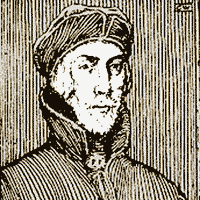Nicolas Jenson

Nicolas Jenson (* 1420 in Sommevoire , France, † 1480 in Venice ) was an important French type designer, die cutter , typographer , calligrapher , printer , publisher and bookseller .
Life
Nicolas Jenson was initially a painter, learned the profession of copperplate engraver and worked at the royal French mint Monnaie de France in Paris , possibly as an engraver , later he was mint master of the city of Tours . On October 4, 1458, the French King Charles VII sent him to Mainz by decree to study the new art of movable type, which was invented by Johannes Gutenberg , and to make his invention usable for France. Perhaps Jenson worked for a long time in Peter Schöffer's print shop , where he was already creating new font styles and permanent hallmarks.
From around 1469 Jenson was in Venice and first worked for the brothers Johannes and Wendelin von Speyer, whom he knew from his time in Mainz. It was there in 1470 that an Antiqua typeface was the first to be created, which was used for printing Cicero's Epistolae ad Brutum (GW 6859). The Jenson Antiqua was the first qualitatively convincing Antiqua in typography history and was imitated throughout Italy in the following decades. A Greek font followed in 1471, and after 1473 a total of five round Gothic fonts or Gotico Antiquas . In addition to a printing company, he ran a bookselling company from 1475. His most important business partners in the years up to 1480 were the Frankfurt merchants Johannes Rauchfass and Peter Ugelheimer . In 1480 the company they founded also merged with the German printers around Johann von Cologne. When Nicolas Jenson died in Venice in 1480, he was a wealthy, respected man and the most important printer-publisher in Venice in the time before Aldus Manutius .
In the Venetian decade, a total of around 100 printing works were created. It was here that Augustine printed De Civitate Dei (The City of God) in 1475 and De proprietate latini sermonis by Nonius Marcellus in 1476 .
Fonts

The writings mentioned after 1470 can clearly be ascribed to Jenson. The Antiqua used by Johann von Speyer in 1469 for Cicero's Epistolae familiares is so similar to that of Jenson that it too may have come from his workshop; Albert Kapr suspects that a font from the printer of the Marienthal monastery could also have come from Jenson.
Modern recuts
The forms of the Jenson Antiqua , created in 1470, are still considered by many to be unmatched in their powerful aesthetics and liveliness. Numerous Antiqua typefaces that emerged at the beginning of the 20th century are based on the character of the Jenson Antiqua or are almost exact copies. In particular, these are the fonts of the private presses : Kelmscott Press (Golden Type), Doves Press , Bremer Presse , Cranach-Presse etc. In 1913 Harry Graf Kessler set up his own publishing house in Weimar under the name "Cranachpresse" and asked Emery Walker to to design a type for his printing press. As he had done in earlier private presses (Kelmscott, Doves and Ashendene), Walker commissioned Edward Prince to cut the letters. Unfortunately, Prince had serious problems cutting the italic font after Giovanni Antonio Tagliente (died 1527 in Venice), despite being helped by Edward Johnston. The types were only completed after Prince's death (died 1923) and were rarely used.
Bruce Rogers developed the Centaur 1912-1914, of which 1928 a variant for the Monotype Corp. arose Morris Fuller Benton the Cloister Old Style (1914) for the American Type Founders (ATF). Modern versions were created with the ITC Legacy ( Ronald Arnholm , 1992) and Adobe Jenson ( Robert Slimbach , 1995); Die San Marco by Karlgeorg Hoefer (1991) is based on Jenson's round Gothic fonts and is therefore suitable for mixing with the listed Antiqua fonts.
literature
- Lotte Hellinga : Nicolas Jenson & Peter Ugelheimer. Friends and business partners . In: Christoph Winterer (ed.), Behind the parchment: the world. The Frankfurt merchant Peter Ugelheimer and the art of illumination in the Venice of the Renaissance. Munich 2018, pp. 152–162
- Martin Lowry: Nicholas Jenson and the Rise of Venetian Publishing in Renaissance Europe. Oxford 1991 ISBN 0-631-17394-3 .
- Lotte Hellinga: Johann Fust, Peter Schoeffer and Nicolas Jenson . In: Gutenberg-Jahrbuch (2003), pp. 16–21.
- Vita von Lieres: Nicolaus Jenson. In: Type foundry D. Stempel AG (Ed.): Old masters of printing. Frankfurt am Main, 1940. pp. 35-40
- Giovanni Mardersteig: The unique chronicle of an incunable. Petrus Maufer's print of Gentile de Foligno's commentary on Avicenna. Padua . Special print in: Philobiblon XI. Volume 1. [Dr. Ernst Hauswedell & Nolte], Hamburg 1967.
- Augustine: De civitate Dei . Printer: Nicolas Jenson, Venetiis 1475
- Stanley Morison and Holbrook Jackson: A brief survey of printing: history and practice Publisher: Alfred A. Knopf, New York 1923
Web links
- Beinert, Wolfgang: Nicolas Jenson, short biography
- Prints by Nicolas Jenson in the complete catalog of incandescent prints
- Augustine : De civitate Dei , Digitized Copy (14759 in the John M. Kelly Library at St. Michael's College, University of Toronto (Canada)).
Remarks
- ↑ Hellinga 2018, pp. 160–164
- ^ Albert Kapr: Johannes Gutenberg. Personality and performance . 2nd edition, Munich 1988. ISBN 3-598-10463-4
- ↑ Edward Prince
- ↑ Edward Johnston
- ↑ Bruce Rogers and the Riverside Press
- ↑ 1923 American Type Founders Specimen Book & Catalog
- ^ Robert Bringhurst: The Elements of Typographic Style. Version 2.5 . Vancouver 2002. ISBN 0-88179-132-6
| personal data | |
|---|---|
| SURNAME | Jenson, Nicolas |
| BRIEF DESCRIPTION | French printer and publisher |
| DATE OF BIRTH | 1420 |
| PLACE OF BIRTH | Sommevoire , France |
| DATE OF DEATH | 1480 |
| Place of death | Venice |
